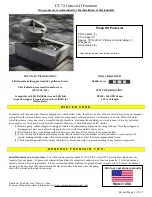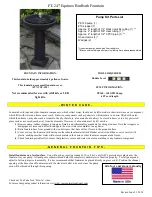
ELECTRICAL SYSTEM AND BATTERY CHARGER
Page H-9
Repair and Service Manual
Read all of Section B and this section before attempting any procedure. Pay particular attention to all Notes, Cautions and Warnings
Capacitor Quick Test
NEVER touch capacitor
terminals with uninsulat-
ed tools or probes, or
with any part of your body, because the high voltage
in the capacitor coil can cause serious injury due to
electrical shock.
To quickly test the capacitor:
Equipment needed: Ohmmeter, with X5 or X10 scale
1. Disconnect the power supply cord from its outlet, and
the DC output connectors from the batteries.
Do not allow leads to contact each other or
other items.
2. Remove the charger from the vehicle.
Use a resistor or 12 volt load to discharge
capacitor.
3. Disconnect one coil lead from the capacitor, being
very careful not to break the wires.
4. Connect one lead from the Ohmmeter to the capaci-
tor.
5. Watch the Ohmmeter reading as you connect the
other lead to the capacitor.
a. If the needle registers a very low resistance, the
capacitor has failed in shorted mode and is no longer
serviceable.
b. If the needle does not move, the capacitor has
failed in the open mode and is no longer serviceable.
c. If the needle “bumps” (registers a significant volt-
age, then drops down to a lower reading), it indicates
that the capacitor is storing voltage and has not failed.
If you are unsure whether the needle bumped up or not,
reverse the leads and watch the meter as the second
lead is touched to the capacitor. The bump should regis-
ter clearly, because a negative voltage is being combined
with a positive voltage.
The Transformer Has A Short Or Burn-out
Failure of the transformer may be caused by natural
aging or premature shorting of adjacent coil turns or over
heating damage. A low or complete lack of output would
be observed, but the transformer may hum when the
charger is on.
The most common cause of transformer over heating
and premature burn-out is the result of misuse, connect-
ing the charger to a battery system of low voltage than
specified on the charger.
Darkening of all the transformer secondary coil windings
is an indication of possible over heating damage. A low
or complete lack of output would be observed on the
ammeter, however the transformer may hum or the AC
line fuse of circuit breaker may blow when the charger is
turned on.
To test the transformer, disconnect the power supply cord
from its outlet and the DC output leads from the batteries.
Then disconnect the transformer secondary coil leads #1
and #4 from the diode terminals and disconnect the
transformer capacitor leads from the capacitor terminals.
Use care when disconnecting the capacitor leads so the
wires do not break.
HIGH VOLTAGE: With
the charger operating,
the charger capacitor
voltage is approximately 650 volts AC. Use extreme
caution when working near capacitor terminals.
In order to apply AC power directly to the transformer pri-
mary coil the Electronic Timer Kit must be bypassed.
With Electronic Timer Kit bypassed and taking care for
personal safety, connect the power supply cord to an out-
let. If the AC line fuse or circuit breaker blows, the trans-
former is shorted internally and must be replaced. If this
does not occur, check the transformer secondary and
capacitor coil voltages using a suitable AC voltmeter. If
the measured voltages are substantially lower than those
shown, the transformer is shorted internally and must be
replaced.
If the transformer secondary coil voltage and the capaci-
tor coil voltage check good, disconnect the power supply
cord from its outlet. Check the capacitor to be sure its rat-
ing is 6 Mfd, 660 volts AC, and then carefully reconnect
the capacitor coil leads to the capacitor terminals.
Then, taking care for personal safety reconnect the
power supply cord to an outlet and measure the trans-
former secondary voltage again. The correct voltage is
shown in figure b. if the transformer secondary voltage
reading is the same as measured with capacitor discon-
nected, from figure a, the capacitor may be open or the
capacitor terminals may not be making proper electrical
contact. If the voltage readings are correct, both the
transformer and capacitor are good.
If it should become necessary to replace a terminal on
one of the transformer leads, the new terminal must be
crimped and soldered.
!
!
!
!
Summary of Contents for MINUTE MISER
Page 7: ...Page iv Repair and Service Manual TABLE OF CONTENTS Notes...
Page 11: ...Owner s Manual and Service Guide SAFETY INFORMATION Page viii Notes...
Page 27: ...SAFETY Page B ii Repair and Service Manual Notes...
Page 37: ...BODY Page C ii Repair and Service Manual Notes...
Page 41: ...WHEELS AND TIRES Page D ii Repair and Service Manual Notes...
Page 45: ...BATTERIES AND CHARGING Page E ii Repair and Service Manual Notes...
Page 55: ...ELECTRONIC SPEED CONTROL Page F ii Repair and Service Manual Notes...
Page 61: ...MOTOR Page G ii Repair and Service Manual Notes...
Page 67: ...ELECTRICAL SYSTEM AND BATTERY CHARGER Page H ii Repair and Service Manual Notes...
Page 81: ...Page J ii BRAKES Repair and Service Manual Notes...
Page 87: ...BRAKES Page J 6 Repair and Service Manual Notes...
Page 89: ...REAR AXLE Page K ii Repair and Service Manual Notes...
Page 95: ...PAINT Page L ii Repair and Service Manual Notes...
Page 99: ...LIGHTNING PROTECTION AND GROUNDING Page M ii Repair and Service Manual Notes...
Page 105: ...GENERAL SPECIFICATIONS Page N ii Repair and Service Manual Notes...
Page 109: ...Page N 4 Repair and Service Manual GENERAL SPECIFICATIONS Notes...
Page 111: ...STEERING Page P ii Repair and Service Manual Notes...
















































